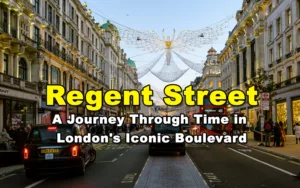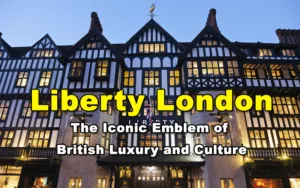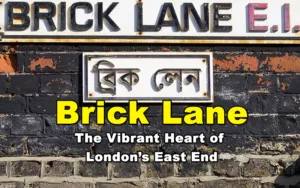Perched gracefully along the Thames in Millbank in the City of Westminster, Tate Britain stands as a bastion of British art, capturing the spirit and evolution of artistic expression over the centuries. From its inception in 1897 as the National Gallery of British Art, and its subsequent rebranding to Tate Britain in 2000, it has steadfastly championed the preservation and celebration of Britain’s artistic legacy.
With a dual mission to both safeguard and promote engagement with British art, Tate Britain curates a sweeping collection that spans from the 1500s to contemporary works, charting the ebb and flow of artistic styles and societal changes. Its extensive compilation, boasting over 70,000 items including paintings, sculptures, drawings, and photographs, ensures a rich and varied experience for all who visit.
Tate Britain truly sits at the epicenter of London’s vibrant cultural world, marking its territory as a major player not just on the British art scene, but globally as well. Every year, the museum beckons to millions, from art lovers and scholarly researchers to those simply curious about the world of art, drawing them in from all across the globe.
Visitors are treated to a spectacular display of British artistry at its finest, spanning across time periods and artistic movements. The hallowed halls of Tate Britain house the legendary works of J.M.W. Turner, whose masterful use of light and color continue to captivate; John Constable, with his romantic landscapes that seem to transport you to another time; and William Blake, whose visionary art challenges and inspires.
But the experience at Tate Britain is not just a journey through the past. The museum also celebrates the here and now, showcasing the innovative and diverse works of contemporary artists. It is this blend of historical richness and present-day creativity that makes Tate Britain a hotspot of artistic diversity and innovation.
Visitors leave with not just an understanding of Britain’s artistic heritage, but also a sense of how contemporary voices are continuing to shape and redefine the art world today. In this way, Tate Britain stands tall as a lighthouse of artistry, guiding the way through the waters of British art, both past and present.
By marrying its commitment to conservation with a vibrant array of research, education, and public programs, Tate Britain ensures that the treasures of British art are not just seen but truly experienced. It invites visitors to immerse themselves in the artistic journey, fostering a profound connection with the works and igniting conversations that resonate in today’s society. Tate Britain thus emerges not just as a custodian of history, but as a living, breathing entity that continues to shape and be shaped by the narrative of British art.
The Architectural Splendor of Tate Britain
Tate Britain stands as a testament not only to the incredible wealth of art within its walls but also to the architectural brilliance of its design. Sidney R. J. Smith’s original structure, completed in 1897, exudes an aura of classical elegance. The neoclassical influence is evident in the building’s balanced proportions, Ionic columns, and the intricate frieze that adorns its façade, all of which collectively contribute to a dignified yet welcoming ambiance along the banks of the Thames.
With the passage of time and the inevitable growth of its collection, Tate Britain has gracefully embraced numerous expansions and renovations. Each architectural endeavor has been meticulously executed, ensuring a seamless marriage between the old and the new. The goal has always been to maintain the integrity of Smith’s original vision while incorporating modern elements to enhance the overall visitor experience.
Upon entering Tate Britain, visitors are immediately struck by the building’s grand entrance, a prelude to the artistic treasures that lie within. The rotunda, bathed in natural light, stands at the museum’s core, offering both a focal point for orientation and a space that evokes awe and wonder. Here, the grandeur of the space complements the art, creating an immersive experience.
The Duveen Galleries, generously named after the art dealer and philanthropist Joseph Duveen, present a highlight of the architectural tour. These galleries house some of the museum’s most notable sculptures within a space defined by its soaring ceilings, abundant natural light, and minimalist design. The intention is clear: to let the art speak for itself.
In recent times, Caruso St John architects have led a significant revamp of Tate Britain, ensuring that the museum meets the needs and expectations of a 21st-century audience. This revitalization has seen the restoration of historic features, the introduction of new educational spaces, and a reimagined display of the collection, offering a more coherent narrative of British art.
The architecture of Tate Britain plays a pivotal role in shaping the visitor experience. The building itself is a piece of art, providing a sanctuary where appreciation for the artworks is heightened. Through a masterful blend of classical charm and contemporary innovation, the museum stands as both a custodian of history and a beacon of the present. In its architectural splendor, Tate Britain manages to create an environment that nurtures connection, sparks reflection, and kindles inspiration.
The Art Collection Housed in Tate Britain
The array of artwork housed within Tate Britain is nothing short of a visual feast, representing over half a millennium of British artistic brilliance. The collection, comprised of more than 70,000 pieces spanning paintings, sculptures, drawings, and photographs, offers a rich and nuanced narrative of the evolution of art in Britain.
The museum’s holdings unfold across various major artistic periods and styles, inviting visitors on a journey through the vast expanse of British art history. In the Tudor period, portraiture and religious motifs dominate, reflecting the socio-political landscape of the time. The Baroque period shifts gears, presenting works of drama and grandeur that epitomize the opulence of the 17th century.
As we move into the Romantic period, a surge of emotion and individual expression takes center stage. Artists dive deep into explorations of the sublime, crafting awe-inspiring portrayals of nature’s might. The Victorian era follows, bringing with it a lens focused on the societal shifts of an industrializing world. Art becomes a tool for commentary, capturing the intricate dance of progress and tradition.
The Modern period marks a radical transformation, as artists break free from conventional forms, experimenting boldly with abstraction, expressionism, and surrealism. The collection’s contemporary pieces carry this torch of innovation forward, pushing boundaries and exploring new mediums and concepts. Throughout these shifting sands of time and art, Tate Britain has stood as a beacon of support for British art, ensuring that works from every epoch are cherished, showcased, and understood.
Key figures from each artistic chapter are prominently featured within the collection, weaving a rich tapestry of diverse artistic experiences for visitors. J.M.W. Turner’s breathtaking landscapes and marine scenes capture the raw, sublime power of nature, while William Blake’s mystical union of poetry and visual art crafts a realm of visionary wonder.
John Constable’s serene pastoral scenes celebrate the English countryside, presenting a pastoral calm that contrasts sharply with the urban tension and societal reflections found in the works of later artists like Henry Moore and Francis Bacon.
A crown jewel of the collection is the Turner Bequest, housed in the dedicated Clore Gallery. This is the world’s most extensive collection of Turner’s works, encompassing a staggering array of paintings, drawings, and sketches. This treasure trove offers a deep dive into Turner’s creative process, themes, and techniques, affirming Tate Britain’s status as the ultimate destination for appreciating and studying this monumental figure in British art.
In essence, Tate Britain’s collection is a veritable encyclopedia of British art, offering visitors a panoramic view of artistic evolution, expression, and innovation. It stands as a living tribute to the resilience, creativity, and diversity of British artists, sparking inspiration and offering profound insights to art enthusiasts from across the globe.
Exhibitions and Programs at Tate Britain
At the heart of London’s cultural vitality, Tate Britain stands out not just for its impressive collection of British art, but also for its vibrant and dynamic exhibitions and educational programs. It’s a place that actively invites visitors to engage, learn, and find inspiration within its walls, making art accessible and relevant to all.
Rotating Exhibitions:
Tate Britain’s program of rotating exhibitions is a true highlight, offering visitors an ever-changing landscape of art to explore. From historical masterpieces to the cutting-edge works of contemporary artists, these exhibitions capture the depth and diversity of British art.
- Historical Art: Dive into the rich tapestry of British art history with exhibitions that explore specific periods, movements, and themes. Tate Britain masterfully curates shows that not only highlight well-known artists and movements but also shine a light on lesser-known figures and artworks, creating a full and immersive experience for visitors.
- Contemporary Art: The museum is also a strong supporter of contemporary art, regularly featuring exhibitions that showcase the works of today’s artists. These shows often include new commissions, encouraging artists to engage with the museum’s collection, architecture, or history, ensuring that Tate Britain remains a vital part of the contemporary art conversation.
- Interdisciplinary Approaches: Tate Britain’s exhibitions often take an interdisciplinary approach, weaving together art, literature, history, and social sciences to provide a comprehensive understanding of the artworks and their contexts.
Educational Programs:
Education is a core part of Tate Britain’s mission, with a variety of programs designed to engage and inspire visitors of all ages.
- Workshops and Talks: The museum offers an extensive range of workshops and talks, catering to everyone from families and school children to art enthusiasts and scholars. These programs provide valuable hands-on experiences and deepen visitors’ connections to the art.
- Tours: Guided tours provide a curated journey through the museum, highlighting key artworks and offering insights into the themes, techniques, and historical contexts of British art.
- Resources for Schools and Teachers: Tate Britain is committed to supporting education, providing a wealth of resources for schools and teachers, including lesson plans, educational materials, and professional development opportunities.
Special Events and Collaborations:
Tate Britain actively engages with the wider art community through partnerships and special events.
- Partnerships with Cultural Institutions: The museum collaborates with other cultural organizations in London and beyond, resulting in joint exhibitions, research initiatives, and exchange programs.
- City-Wide Art Events: Tate Britain plays a central role in London’s art scene, participating in city-wide art festivals and events, connecting with the broader artistic community, and contributing to the cultural vibrancy of the city.
Tate Britain’s diverse exhibitions and educational programs ensure that British art remains a living, breathing part of the cultural landscape, accessible and inspiring to all. The museum stands as a vital institution, not just for art lovers, but for the entire community, fostering a deeper understanding and appreciation of art.
The Visitor Experience
Stepping into Tate Britain, visitors embark on a journey that is far more than a mere exploration of British art’s history—it’s an engaging, educational, and inspiring experience tailored for all. The museum prides itself on creating a welcoming atmosphere, ensuring that the rich tapestry of Britain’s artistic legacy is accessible to every visitor, regardless of their age or background.
Tips and Recommendations for Visitors:
Navigating through Tate Britain’s vast collection and taking full advantage of what the museum has to offer is a breeze with these handy tips:
- Best Times to Visit: Escape the crowds by visiting on a weekday morning. While weekends and holidays are busier, they buzz with a vibrant atmosphere and offer additional guided tours.
- Must-See Artworks: Don’t leave without exploring the Turner Bequest in the Clore Gallery, admiring the Pre-Raphaelite paintings, and soaking in the masterpieces by William Blake and John Constable. Make sure to check the museum’s website for up-to-date information on current exhibitions and events to maximize your visit.
- Visitor Amenities: Whether you’re in need of a quick bite or a leisurely meal, the café and restaurant have you covered. And don’t forget to stop by the museum shop for a wide selection of books, prints, and souvenirs to remember your visit by.
Accessibility and Inclusivity Efforts:
Tate Britain is unwavering in its commitment to accessibility and inclusivity, ensuring art is for everyone:
- Programs and Facilities for Diverse Audiences: The museum goes the extra mile to cater to visitors with disabilities, offering guided tours with British Sign Language interpretation, touch tours for visually impaired guests, and serene sensory spaces.
- Facilities: The entire museum is wheelchair accessible, and mobility scooters are available for loan. Quiet spaces are also at hand for those who might need a break from the galleries’ bustling environment.
Role in the Community:
Tate Britain is not just a museum; it’s a community hub actively engaged with the local populace:
- Outreach Programs: The museum reaches out through art workshops in schools, community art projects, and partnerships with local organizations.
- Volunteer Opportunities: There are ample volunteer opportunities, inviting individuals to learn, give back, and become an integral part of the Tate community.
- Contribution to Local Culture and Economy: As a premier cultural institution in London, Tate Britain significantly influences the city’s cultural scene and economy, drawing tourists, creating jobs, and actively participating in city-wide cultural events and initiatives.
Tate Britain is more than a repository of art; it’s a living, breathing space that encourages a profound connection between art and the public. Through its commitment to accessibility, community engagement, and enriching visitor experiences, the museum ensures that British art continues to thrive and resonate in the heart of contemporary culture.
The Future of Tate Britain
Tate Britain’s legacy as a custodian of British art is intrinsically linked to its ability to evolve, adapt, and innovate. The museum has recently undergone significant renovations and updates, ensuring its continued relevance and resonance in the 21st century. As we look ahead, the museum’s role in contemporary art and its commitment to future exhibitions and programs reveal a vision that is as ambitious as it is inclusive.
Recent Renovations and Updates:
Enhancements to the Visitor Experience: The comprehensive renovations led by Caruso St John architects have revitalized Tate Britain, creating more open, navigable, and engaging spaces. This includes the reopening of the main entrance, the creation of new gallery spaces, and the introduction of state-of-the-art facilities.
Preservation of the Collection: Alongside improvements for visitors, the renovations have also included vital updates to the storage and preservation facilities, ensuring that the museum’s extensive collection is maintained for future generations.
Plans for Future Exhibitions and Programs:
Upcoming Attractions: Tate Britain continues to curate a diverse program of exhibitions, showcasing everything from historical masterpieces to cutting-edge contemporary art. The museum’s commitment to British art ensures a balance between celebrating past achievements and fostering new talent.
Long-Term Vision: The museum’s long-term vision involves strengthening its role as a center for artistic excellence, education, and engagement. This includes ongoing efforts to enhance accessibility, expand educational programs, and engage with broader audiences.
The Museum’s Role in Contemporary Art:
Encouraging Dialogue: Tate Britain plays a crucial role in fostering dialogue and engagement with contemporary issues through its collection, exhibitions, and programs. The museum is committed to presenting art that reflects and responds to the social, political, and cultural contexts of today.
Support for Contemporary Artists: The museum’s support for contemporary artists ensures a living connection between the historic collection and the art of today. This involves not only showcasing contemporary works but also providing platforms for artists to create and engage with the museum’s spaces, collection, and audiences.
In conclusion, the future of Tate Britain is one of continued evolution, commitment to excellence, and engagement with both the art and the audiences of today and tomorrow. The museum’s recent renovations, its dynamic program of exhibitions and events, and its ongoing role in contemporary art mark it as an institution that is both rooted in history and vibrantly alive in the present, ensuring that British art continues to inspire, challenge, and connect with people from all walks of life.
Summing Up Tate Britain
Tate Britain emerges as a formidable sanctuary of artistic brilliance and a treasure trove of cultural history, making its mark not just in the United Kingdom, but on the global art stage. Since its establishment in 1897, the museum has unwaveringly devoted itself to the celebration, preservation, and interpretation of British art—a devotion that has only deepened with the passage of time. Today, it proudly houses a staggering collection that spans 500 years, offering an unmatched exploration of the artistic, cultural, and societal evolution of Britain.
The architectural majesty of Tate Britain, ranging from Sidney R. J. Smith’s original grand design to the thoughtful and contemporary renovations, creates a space that is as awe-inspiring as it is inviting. The museum ensures a top-tier visitor experience through an array of amenities, initiatives for accessibility, and educational programs, affirming its commitment to being a space open to all.
With a lively schedule of exhibitions and events, Tate Britain consistently introduces fresh and innovative perspectives to its collection, nurturing engagement with both the historical and the modern facets of art. It stands as a vital player in today’s art scene, fostering support for artists and sparking conversations on contemporary issues through the artistic lens.
We warmly invite readers to immerse themselves in the richness, history, and artistic abundance that Tate Britain has to offer. Whether you are captivated by J.M.W. Turner’s luminous canvases, intrigued by the mystical allure of William Blake’s creations, or drawn to the groundbreaking spirit of modern British artists, Tate Britain has something that will speak to you.
Looking at Tate Britain’s role in the art world today, it is clear that we are witnessing a museum that not only safeguards our historical treasures but also actively participates in the ongoing artistic dialogue and sets its sights on future horizons. It is an institution in constant evolution, ready to meet the demands of modern times while remaining true to its core mission of celebrating and showcasing British art.
By preserving the intricate tapestry of British art, Tate Britain ensures that generations to come will continue to engage with, learn from, and find inspiration in the nation’s rich artistic heritage. It stands as a living testament to art’s enduring ability to capture our history, mould our present, and ignite our future.
“I may earn commissions as an affiliate from sponsored links within this post”








